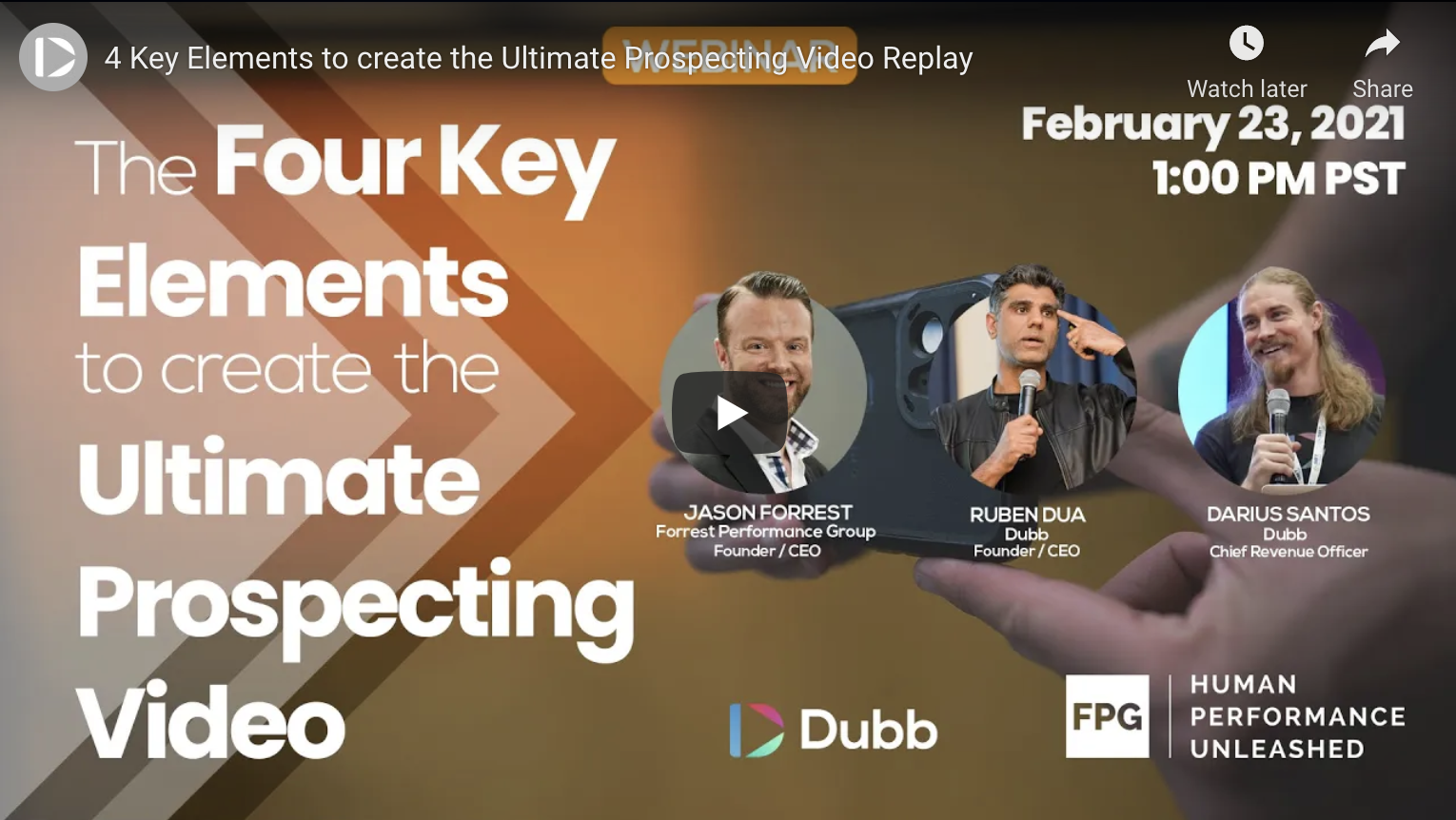Have you been searching for a way to create the ultimate prospecting video? If so, you are definitely in the right place.
In this blog post, I want to share some awesome insights on how you can make the best prospecting video for your business. Whether you are a solo founder or work with a larger team at a larger business, the ultimate prospecting video can help you find new clients and build substantial brand equity. In other words, while there is some upfront work, it can provide immense value down the road.
To help us explore the four key elements to create the ultimate prospecting video, Dubb Chief Revenue Officer Darius Santos and I spoke with Jason Forrest. Jason is the CEO of Forrest Performance Group, which is focused on delivering the ultimate sales warrior. Ultimately, Jason and his colleagues work hard to help their colleagues master the art and science of human performance. Part of their work involves prospecting through video and Jason is a true expert and practitioner in this area.
To view our entire one-hour discussion with Jason, go ahead and click here. However, if you’d like to get a CliffsNotes version of the conversation, continue reading.
The Four Elements
As Jason described, the four elements to create the ultimate prospecting videos come from his own experience. At Forrest Performance Group, he and his colleagues are proud of being true practitioners in their craft. They don’t recommend tips or strategies to their clients unless they have personally tried them out. In other words, they field test these ideas and strategies themselves. This way, they can maximize the odds of helping their clients achieve the best results.
In their day-to-day work with their clients, Jason and their colleagues leverage the power of neurolinguistic programming (“NLP”). This is especially true when talking about these four key elements to create the ultimate prospecting video. As Jason says, the way that we speak to ourselves is a window into how we think. How we think drives how we feel. How we feel drives our motivations. From there, our motivations drive our behaviors and our behaviors drive our results.
If you logically put them together, the way that we speak drives our results. It is possible to program people through our words. Keep this in mind as we discuss the four key elements of a stellar prospecting video. Whether you are an NLP novice or an NLP expert, you will notice that NLP makes up a large part of these four elements.
So, on to the elements. The four key elements to creating the ultimate prospecting video are (1) disrupt the pattern, (2) make it personal, (3) teach them something, and (4) include a call to action. As Jason says, these four elements can be shortened to “DPTC.”
Disrupt the Pattern
The first key element of creating the ultimate prospect video is to disrupt the pattern in your audience’s lives. Ultimately, we want to disrupt the pattern because there is so much noise out there.
The good news is that we can disrupt the pattern. All of us get blanket templated emails, whether they are connection requests on LinkedIn or cold emails sent to us and our colleagues. By sending a video in your own prospecting work, however, you can disrupt the pattern. When video does become commonplace, you will also need to disrupt the pattern in your videos to make yourself stand out.
In the webinar, Jason shared plenty of examples of how you can disrupt the pattern and stand out via video. For instance, Jason played a goofier video in the earlier days of Covid-19. The video showed him explaining how he didn’t know how to put a mask on, but he did know how to drive profitable sales for his clients. From there, Jason spoke for about one minute on Forrest Performance Group can provide massive value to all types of organizations. To wrap up the video, he invited viewers to message him back or schedule a time on his calendar. By uploading that video to Dubb, Jason was also able to leverage the playlist feature to provide even more value to the viewer.
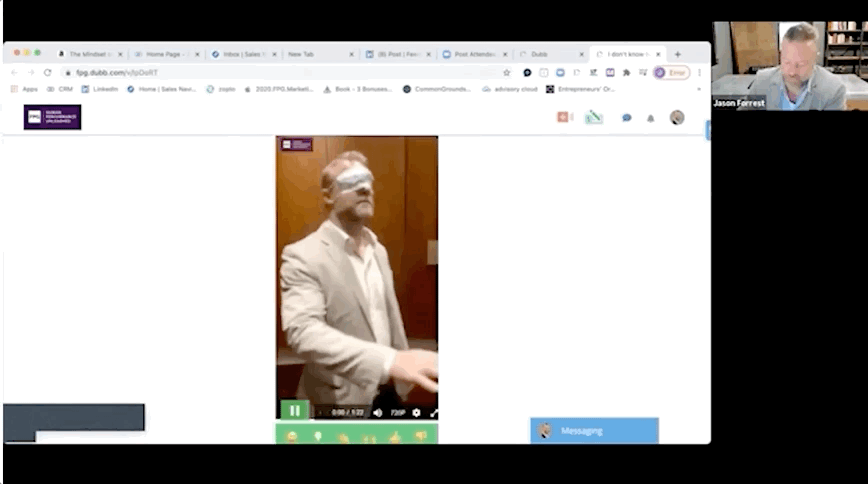
The bottom line, however, is that Jason disrupted the pattern in his video. It started off with him immediately wearing a mask incorrectly on his face. It captured the audience’s attention, and then from there, he teaches his audience something that they haven’t known before. A call to action presents a nice conclusion to a quick video.
Jason has disrupted the pattern in many other ways as well. For instance, if you have an iPhone, you can create your own Memoji. Once you have created your Memoji, you can film yourself using Apple Clips and then add it to Dubb. You can then send out that Memoji to your audiences. It is another way to disrupt the pattern and grab your viewer’s attention—even before they get to the crux of your video.
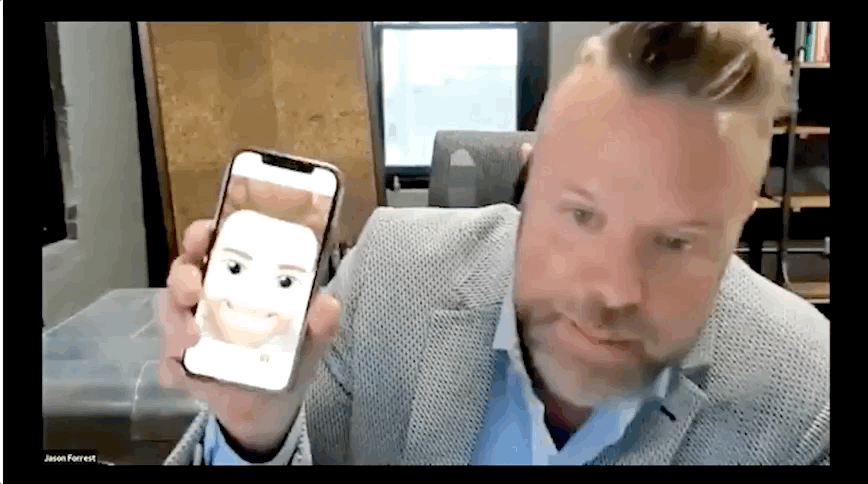
Jason also showed another video that was a great example of disrupting the pattern. He went to hiresanta.com and paid around $100 for one of their Santas to read a script. Once he received the video, he uploaded it to Dubb and created a personalized video on the end of each one of them. This is another case of Jason disrupting the viewer’s pattern and then appending a personalized video to that Santa video. You get the best of both worlds: not only do you get to jar the viewer awake and immediately grasp their attention, but you can send them a hyper-personalized message, thereby increasing your chances of making a sale.
You can disrupt the pattern by generating ideas yourself or by working with talented freelancers on Fiverr or Upwork. No matter how you get it done, definitely try to disrupt the pattern in your first few seconds of the video. Doing this helps you make a statement early in your video, which overwhelmingly increases your chances of a particular viewer tuning in for more.
Make It Personal
Personalization is the next key element to create the ultimate prospecting video. Personalization is an essential component of any prospecting video because it treats members of your audience like human beings. By singling them out, you can build a close rapport with each audience member. You start treating them like an individual, which will go a long way in building a solid, organic relationship.
It seems pretty obvious. However, you may be wondering how you can leverage personalization in practice. Jason offered several ways that you can do so. For instance, in his videos, he will sometimes have a laptop in the background. That laptop will contain the viewer’s website and it will be easy to see in the video. While it may seem small, this display adds a personal touch to your video. It shows your viewer that you have researched them and that you’ve taken the time to make a video just for them.
You can also leverage personalization when you are using Dubb. For example, when Jason creates a video using Dubb, he shares his screen and includes the viewer’s LinkedIn profile. So when sending the video to the viewer, the picture is their LinkedIn profile. It’s very rare for someone not to click on a video that includes an image of themselves. By building rapport through personalization, it makes it much easier to leverage the other elements in the ultimate prospecting video.
These are just several ideas of the way that you can personalize your prospecting videos. There are plenty more. For instance, using Dubb, you can add personalization text at scale. No matter the video that you are sending, you can easily include each recipient’s name at the top of your video. So no matter the type of video that you’re sending, make sure that you are including personalization in all of your content.
Teach Your Audience Something
The third element of the ultimate prospecting video is teaching your audience something. To Jason, the teach element is all about the two or three things that you can relay to your audience.
Jason and his colleagues have discovered a key element from their Warrior Selling work. Specifically, they found out that customers are not looking for a faux friend. Even though we may think that we need to act like their friend, acting this way isn’t going to drastically increase your chances of making a sale. Instead of this, your customers are looking for an advisor. In other words, they are looking for someone that they mutually respect and that can take them to a place that they wouldn’t be able to go on their own.
As Jason says, the goal of any sales warrior is to help human beings move away from pain and move towards life improvement. So how can you do this?
One quick and easy way to provide value to your viewer is to leverage Google Alerts. You can create a Google Alert on virtually anything, whether it is related to your industry or something personal to that prospect. You can include trends that you’re seeing in your industry or even economic data. Even better, you can send over data that competitors reveal in public earnings calls.
Because this is so personal to each viewer, you are going to need to think long and hard about the type of value that you’re providing. If you are sending a video to a larger audience, for instance, you may want to focus on how your product or service can solve a key problem in their lives. If you are sending a hyper-personalized video, make sure that your offering is much more customized. Whatever the case may be, make sure that you are prioritizing education in your videos. Focusing on teaching your audience something will make your prospecting video much more engaging and effective.

Use a Call to Action
The three elements above may seem like a perfect encapsulation of a great prospecting video. Disrupting the pattern gets your audience’s attention. Personalization makes your audience members stand out and feel a tangible connection with your organization. And teaching your audience something creates real value and establishes your status as an advisor rather than a friend.
All of this is well and good. However, without including a call to action, all of your work will essentially be for naught.
As you probably already know, calls to action are powerful tools to move a prospect down your sales pipeline. They direct your viewer to take some other action after watching your video. This action can be any number of things. For instance, Jason typically includes one of two calls to action at the end of his videos. Those calls to action are for viewers to send an email back to Jason or to book a time directly on Jason’s calendar.
Those aren’t the only calls to action you can leverage, however. For instance, using a tool like Dubb, you can include all types of calls to action. From completing a form and downloading a white paper to reaching out through Facebook Messenger or replying with video, we are proud to offer many different types of calls to action.
Whichever call to action you select, make sure that you are including at least one in your video. Even if you think they seem too “salesy” or “pushy,” calls to action are an essential component of the ultimate prospecting video. Don’t ignore them when you are creating your prospecting videos.
Capitalizing on the VETO Selling Message
At this point, we have discussed the four key elements to create the ultimate prospecting video. By incorporating all four of these elements, your video will be much more likely to accomplish your specific goals.
That’s not all, however. As Jason described in the webinar, another important element that you should consider when making video content is the VETO selling message. Specifically, “VETO” stands for vision, example, teach, and own. If Jason had to categorize it, the VETO selling message would be in the “teach” subcategory of the four key elements of creating the ultimate prospecting video.
Ultimately, the VETO selling message is all about vetoing the customer’s current perspective on what they think about you. In other words, you want to carve out a niche in your customer’s mind so that they see you differently.
With your vision, you want to share what is unique about you. It’s the answer to the following question: “The reason people choose us is ______.” Or you can answer: “When our founder decided to create the company, the goal was to ______.” Answering these types of questions can make your company’s vision much more clear, which you can then articulate to your viewer or prospect.
The “E” in VETO stands for evidence. You want to share examples of how you helped a certain business go from A to B. You want to gather those stories and then share those stories with your prospects or viewers. It’s a good idea to make this extremely clear.
The “T” stands for teach. The teaching element is about showing how you helped that business goes from A to B. For example, you can say “The three ways that we helped this company go from A to B are X, Y, and Z.” These specific examples provide some great color to your value proposition and educate your prospect on how you have improved other customers’ lives.
Finally, the “O” in VETO stands for own. The own is about making it personal to the prospect or viewer. For instance, when pitching them, you can say something like, “What this would look like for you is ____” or “If you decided to work with us today, this is how it is going to work.” The own is putting the vision and evidence in their world. It is making it immediately applicable to them.
The VETO is everything to Jason and his colleagues. It helps them differentiate themselves versus their competitors and helps them hone in on the exact value that they are providing to prospects and customers. It even helps to have your VETO in video form. You can then append that video to any other type of video content that you distribute. Whether you are sending a hyper-personalized video to one prospect or are sending a mass video to your email list, including your VETO video as part of a playlist feature can be a game-changer.
How Dubb Can Help You Accomplish Your Video Marketing Goals
As you have seen, the four key elements of creating the ultimate prospecting video, along with the VETO selling message, can help you accomplish your sales and marketing goals. It works for the smallest startups to the largest organizations. Because of this, I encourage you to incorporate them in your video sales and marketing work.
To make your job that much easier, you may want to consider Dubb. Dubb is an all-in-one video communication tool. We give our users the ability to create their video content, package their content up so that it is professionally branded and designed for your business, and then distribute your content through the channels that you are already using.
Creation Tools
First, let’s talk about the creation tools that you get with Dubb. It begins with our Chrome Extension. The Dubb Chrome Extension gives you the ability to record a video as easily as you could type a message. All you need to do is click the Dubb icon in your toolbar. Then, you will see a whole host of options, including the ability to immediately record your screen, webcam, or both at the same time. When you hit record, you can see a whole host of features you can leverage. For instance, there is our annotation tool, which lets you draw and highlight certain elements on your screen. You can even resize your screen and show some slides—all with your face still in the recording. Once you are done recording, you click one button and upload it to your Dubb account.
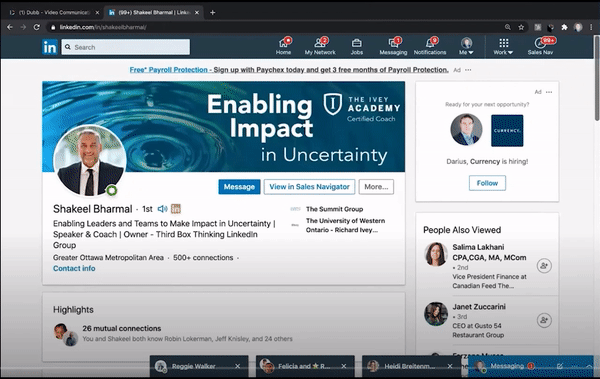
The Chrome Extension is just one easy way to record video content. You can also take advantage of the many integrations that Dubb offers. Whether you are using LinkedIn, HubSpot, Gmail, Salesforce, or something else, you can easily create videos using Dubb. In fact, you can record a video inside the platform, saving you time and energy when making your video content.
Lastly, Dubb’s mobile app is a stellar way to create video content. You can find the mobile app for iOS and Android devices. Simply put, the mobile app has a ton of functionality. For instance, you can start recording a video of your face and then turn the camera around to record your surroundings. You can record multiple clips and easily splice them together. You can even include royalty-free music, text overlays, and leverage the app’s teleprompter mode. We are always building out new features, so I encourage you to download the mobile app and try it out for yourself.
Customizing Your Videos
From creation, Dubb lets you easily customize your videos. What Dubb does is package your videos up so that it best serves your brand and specific purpose.
Whenever you create a video and upload it to Dubb, the software automatically creates an action page for you. These action pages are based on presets. They’re like templates that you can easily switch between. No matter your business goals, you can find a preset that best suits you.
Whichever template you choose, the action page resulting from that template can be completely customized. You can include a custom background, your organization’s logo, your fonts and colors, and more. All of the basic branding elements can get added to your Dubb action page. You can think of every Dubb action page as an extension of your brand. Whether you recorded a one-to-one video or a one-to-many video, your action page offers a great opportunity to showcase your brand and build a strong relationship with your viewers.
The bottom part of your action page are the call to action and playlist sections. Like I discussed above, calls to action are an essential part of any business video. On your Dubb action page, you can choose to include one (or several) calls to action that you think will accomplish your business goals.
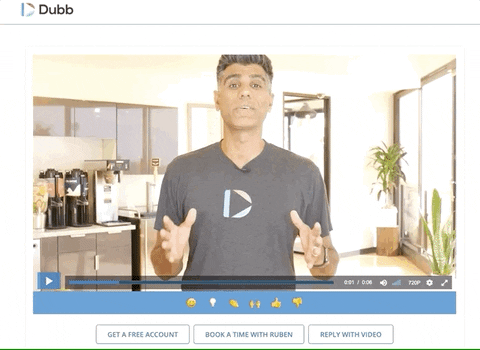
Along with this is the playlist feature. The playlist feature is an awesome tool where you can stack videos on top of each other. Like I mentioned above, it’s a great opportunity to include your VETO selling message. No matter your audience, you can tack on your VETO selling message video at the end of your initial video. Ultimately, the playlist feature is all about efficiency—especially when it comes to prospecting. You control what content is played at the end of your videos (unlike YouTube).
Distribution
Finally, let’s talk about sharing your video. Once your video is ready to go, you can distribute it in several ways.
The first way is through direct integrations. Dubb’s direct integrations inside LinkedIn, HubSpot, Salesforce, and more let you easily distribute your content. Once you click on the Dubb icon inside those platforms, you can easily drop your video onto the platform.
If, for some reason, we don’t have a direct integration with your platform of choice, you can always use the second distribution method. This is the universal copy and paste option. Whatever system that you’re using, you can universally copy and paste your videos into those channels.
When distributing your videos, you also get to leverage plenty of tracking data. Anytime that you send a video through Dubb, that video gets tracked through some detailed analytics. These are much more detailed than you would get when sending a video through email. You can see who watched your video, the percentage of the video watched, and more.
![]()
Finally, Dubb has a fully-functioning CRM. You can store all of your contacts within this CRM and keep them filtered and sorted through tags and lists. You can customize your columns, keep notes on certain contacts, and more. You can also connect your bulk email providers to Dubb and send out batch emails through your own Gmail or Outlook. These are all personalized, mail-merged emails, where the subject and body are all personalized for the recipient. You can even leverage automated sending, so that certain emails are going out based on your audience’s behavior.
Ultimately, Dubb offers a wealth of value. If you are interested in learning more about Dubb and how it can help you, click here. You can also click here to sign up for a free seven-day trial of our premium plans.

